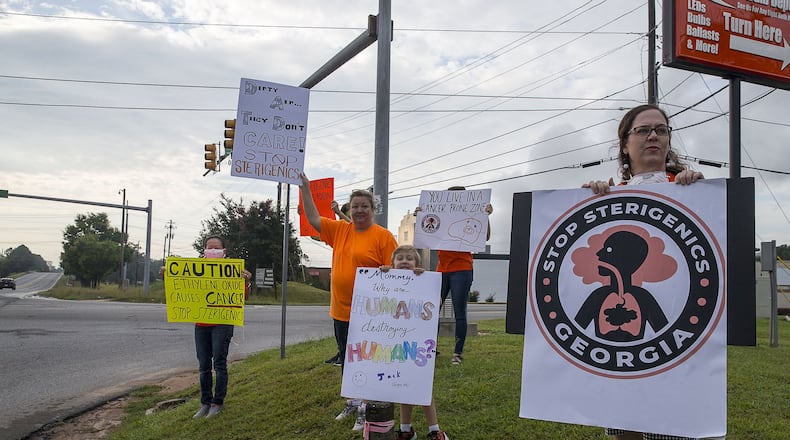The state’s first air test for a carcinogenic gas used by several industrial facilities across Georgia showed it at a level well above what is deemed acceptable by federal regulators, The Atlanta Journal-Constitution has learned.
Ethylene oxide has been a cause for concern in communities close to medical sterilization plants in Cobb and Newton counties that emit the gas. In June, state officials took an air sample at the state Environmental Protection Division's monitoring site in south Dekalb County with the goal of establishing a baseline.
But even miles away from any known source, the level of ethylene oxide captured by the state’s air monitor is 15 times higher than what federal regulators say could cause 100 additional cancer cases per 1 million people exposed over many years.
The federal Environmental Protection Agency, which analyzed the sample, said in a statement that the test result is a preliminary estimate.
The agency is “working … to better understand the distribution of this chemical in the air and to identify potential sources,” it said. “The sample collected at the South DeKalb monitoring site provides a measurable level of ethylene oxide that cannot clearly be linked to a particular source.”
The statement did not outline concrete steps the agency would take, such as additional air testing.
Ethylene oxide has been linked to industrial sterilization plants like Sterigenics, near Smyrna, and BD Bard, in Covington, as well as oil refineries, vehicle exhaust and burning biomass materials like tobacco.
Richard Peltier, an expert in air pollution exposure at the University of Massachusetts, Amherst, said the result of a single air sample should be viewed with caution — it doesn’t provide information about the level of exposure for the entire metro population or whether levels of the gas change from day to day, he said.
“Nor does it tell us if there are places that are much cleaner (and with lower risk) or, more ominously, much worse with a substantially increased risk of cancer for community members,” Peltier wrote in an email. “The point here is that the surveillance by the EPA … is woefully inadequate and they are choosing the now-default pathway of sticking their head in the sand.”
Concern over emissions from the plants in Cobb and Covington was stoked after a federal air quality assessment was updated to reflect the higher toxicity of ethylene oxide, which the EPA reclassified in 2016.
A Sterigenics spokesman provided the AJC with a statement saying the company has not reviewed results from the air monitor in Georgia, but that detection levels in cities such as Chicago, Denver, and downtown Los Angeles have all been found to greatly exceed the level that EPA says is acceptable.
“We would expect that ambient air samples — including those taken far away from known ethylene oxide sources — would indicate measurable levels … because ethylene oxide is produced by a variety of natural and man-made sources that exist in the air around us,” the statement says.
Georgia Sen. Jen Jordan, D-Atlanta, said she was not informed that the state had the results of its first test. She said it is “outrageous” that state regulators are still trying to establish a baseline for ethylene oxide while children attend school around the Cobb plant every day.
Jordan filed a petition in July asking the Centers for Disease Control's Agency for Toxic Substances and Disease Registry to carry out an evaluation of health risks from emissions at the Sterigenics plant in Cobb County.
“What really matters, as far as I’m concerned, is trying to determine how much is in the air around the areas where people are living and breathing this in,” she said. “It seems like that should be the priority and once again it’s on the back burner.
“It’s just unacceptable.”
Elected leaders pledge independent testing
Since the EPA reclassified ethylene oxide as a carcinogen in 2016, testing across the country has shown the chemical is far more pervasive than originally thought, even in undeveloped areas.
The chemical industry has seized on those findings to push back on proposed regulation, arguing that it cannot be held responsible for all the ethylene oxide in the air.
But public health experts and communities close to sources of the gas say higher-than-expected ambient concentrations are not a reason to ignore industrial emissions.
Local and state elected officials have pledged independent testing around facilities that emit ethylene oxide, as communities close to plants expressed frustration with the state's response. Cobb commissioners on Tuesday approved $40,000 for independent air testing around the Sterigenics plant.
A similar facility in Willowbrook, Illinois was shut down after independent testing showed high levels of ethylene oxide in the area. That testing was conducted over 30 consecutive days and paid for by the municipality.
State officials have been working behind the scenes with the companies in question to reduce emissions since they were first flagged in the federal EPA report last August, according to emails reviewed by the AJC. But the state made no effort to inform residents. The heightened risk was first reported by WebMD and Georgia Health News.
Since then, Richard Dunn, the director of the Environmental Protection Division, has side-stepped questions about whether his agency would take more aggressive action.
“The quickest, most effective way to get results is to work with these companies to reduce emissions voluntarily,” Dunn said in a statement to the AJC earlier this month.
Karen Hays, chief of the Air Protection Branch of the Georgia Environmental Protection Division, wrote in an email that the state plans to analyze more air samples from its monitor in DeKalb before conducting tests near known sources of ethylene oxide emissions.
State officials have been told by the EPA that background concentrations of ethylene oxide across the nation “are well above expected levels.”
One sample taken from a wildlife reserve in rural Kentucky measured higher than the EPA’s threshold. In this context, Hays said, the results from Georgia are about average.
Ethylene Oxide
Ethylene Oxide is a combustible gas that causes cancer. Levels of ethylene oxide are measured in micrograms per cubic meter, which is weight per volume of air. An air sample captured in June by the state’s air monitor in DeKalb County found the level of ethylene oxide at 0.309 micrograms per cubic meter, which is 15 times higher than the federal EPA’s threshold of 0.02 micrograms per cubic meter. Exposure to 0.02 micrograms per cubic meter of ethylene oxide over many years could cause 100 additional cases of cancer per 1 million people.
About the Author
The Latest
Featured



